UPPW-11 - Part 2
February 7, 2004
Problem :Bethanechol chloride C7H17ClN2O2
Not any result for two ICDD entries (43-1748 and 46-1964),
both Grant-in-Aid, this was an interesting case for investing more
efforts.
Two new powder patterns were recorded, one from conventional
X-ray data and the other from synchrotron radiation. Try to
index with both data for comparison. Peak positions come
from the application of the PowderX and WinPLOTR programs.
The raw data are also available, so that you may try by yourself
(bethanechol.zip, see the readme.txt file inside).
1- Conventional X-ray data
2- Synchrotron radiation data
3- RESULTS
1- Conventional X-ray data
Wavelength : CuKalpha
Bragg Brentano geometry
Diffractometer : Bruker D8 Advance
Filter : graphite monochromator in the diffracted beam
Soller 2°, variable slits V6/V6, Soller 2°, receiving slit 0.1mm.
Sample pressed on a silicium zero-background holder - there
is a huge preferred orientation...
Peak positions extracted after Kalpha2 removal by PowderX :
Use a wavelength = 1.54056 A
2Theta d (A) Height Area FWHM
10.765 8.21189 586.4 5048.1 0.0900
13.522 6.54300 267.4 2659.7 0.1000
14.690 6.02503 1220.2 12200.8 0.1000
15.398 5.74973 1011.1 9639.7 0.1000
16.336 5.42166 651.7 5422.6 0.0900
16.453 5.38340 907.6 7253.9 0.0800
17.312 5.11797 1057.6 10563.0 0.1000
18.828 4.70937 4046.6 38944.4 0.1000
19.699 4.50305 604.1 4518.1 0.0800
20.031 4.42900 37355.4 372792.8 0.1000
20.752 4.27682 29949.5 262874.6 0.1000
21.641 4.10301 1410.0 11674.2 0.0900
22.414 3.96332 1727.5 17143.8 0.1000
22.788 3.89913 338.3 3085.2 0.1000
23.152 3.83862 399.0 3572.5 0.0900
23.528 3.77803 717.7 7108.4 0.1100
23.872 3.72444 3541.2 34941.0 0.1100
24.970 3.56314 3271.3 44472.8 0.1400
25.365 3.50843 343.4 3678.3 0.1100
25.549 3.48368 471.1 4696.7 0.1100
26.653 3.34175 1484.9 16158.0 0.1100
27.292 3.26492 6395.6 70220.6 0.1100
27.404 3.25188 378.2 4152.2 0.0900
28.153 3.16705 1547.6 15997.6 0.1100
29.345 3.04109 483.0 5163.2 0.1100
29.634 3.01202 3439.0 37394.7 0.1100
29.859 2.98982 388.4 4271.8 0.1100
30.737 2.90641 368.3 3118.0 0.1000
31.038 2.87896 917.7 14029.6 0.1600
31.346 2.85138 1085.6 10555.1 0.1000
31.694 2.82083 694.5 6890.7 0.1000
31.981 2.79615 304.0 2601.9 0.1100
32.704 2.73596 2645.2 26031.0 0.1000
32.986 2.71319 265.8 3386.3 0.1300
33.259 2.69156 960.7 9169.6 0.1000
33.572 2.66721 2790.6 30643.6 0.1100
33.824 2.64791 1487.4 14439.3 0.1000
34.273 2.61426 2272.4 22636.6 0.1000
34.473 2.59953 1041.1 10374.5 0.1000
35.072 2.55647 780.5 8561.6 0.1100
36.330 2.47079 216.5 2598.4 0.1200
36.761 2.44281 1122.5 12337.7 0.1100
38.632 2.32872 514.3 5257.9 0.1100
38.939 2.31106 270.0 2965.8 0.1100
39.722 2.26728 494.3 5168.9 0.1100
39.920 2.25645 272.3 2502.2 0.1000
Plot of the peak extraction with PowderX :
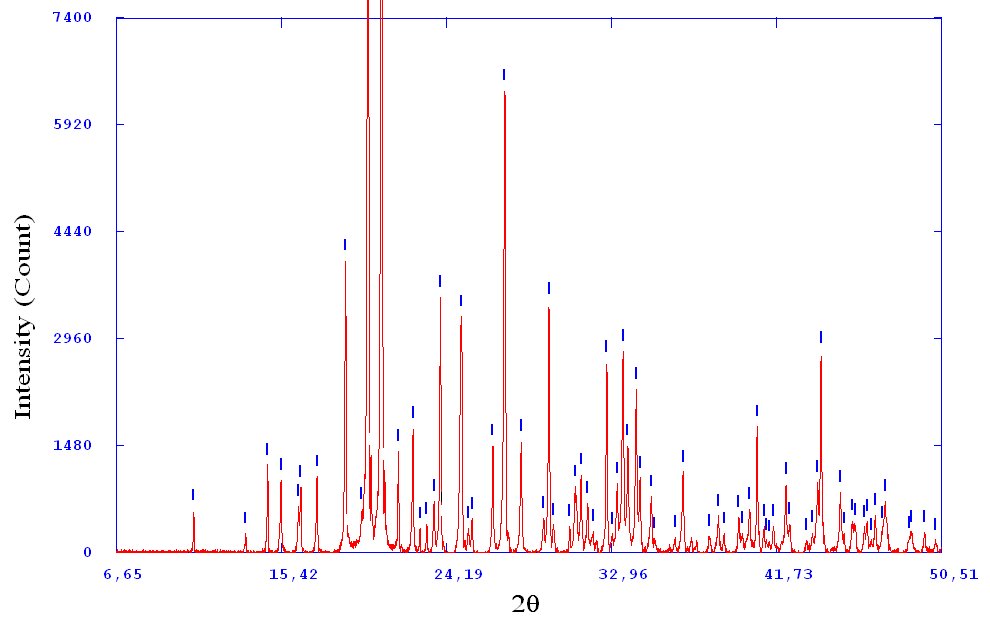 You may also use WinPLOTR for peak position extraction:
You may also use WinPLOTR for peak position extraction:
2-theta Intensity
10.77139 851.57367
13.52686 495.88849
14.69663 1621.39709
15.40200 1493.84937
16.34025 1053.72449
16.45465 1420.88977
17.31883 1549.34705
18.83232 5224.92920
19.71169 1037.66187
20.03352 42190.27730
20.75316 35701.29300
21.64195 1928.24133
22.41502 2412.89478
22.78733 675.22955
23.15637 744.61774
23.53123 1123.72656
23.87491 4531.69043
24.99511 4739.06250
25.55305 819.55084
26.66311 1964.76892
27.29758 8198.01758
28.16043 2001.15540
29.36309 857.51581
29.64191 4131.47461
30.73515 654.15381
31.08307 1412.29028
31.34560 1537.70874
31.69426 1116.46436
32.70807 3149.14478
33.26403 1433.92297
33.57528 3590.28076
34.27499 2907.26660
34.46975 1580.02295
35.07713 1215.08728
36.76001 1598.01526
38.63772 870.49487
38.93926 613.23083
39.72001 855.00787
40.29115 1040.59851
40.69636 2157.91284
Pmot of the peak position extraction with WinPLOTR:
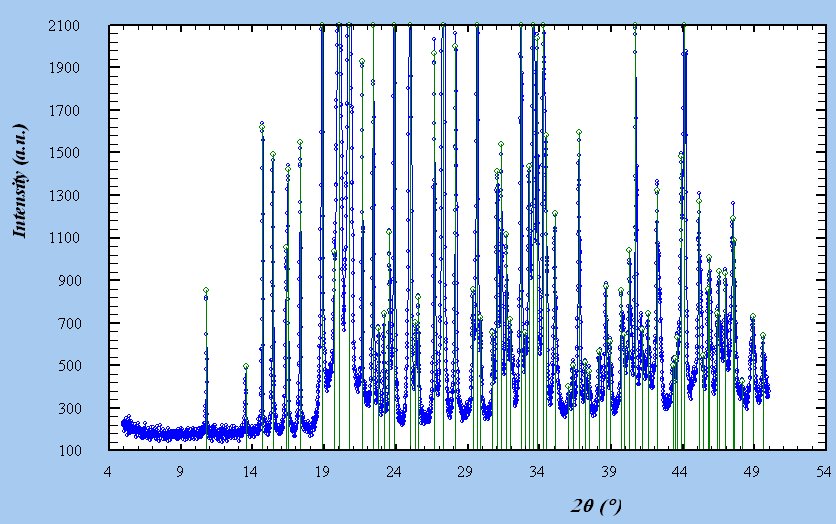
2- Synchrotron radiation data
From Peter Stephens :
This was in a capillary, rotating 5 degrees at each point. The x-ray
wavelength was 0.6995(1) Angstrom. Peak positions determined using TOPAS.
2-theta
4.887
6.139
6.664
6.989
7.403
7.460
7.850
8.531
8.921
9.062
9.251
9.386
9.781
10.136
10.300
10.468
10.634
10.783
11.280
11.450
11.538
12.032
12.309
12.693
Diffractometer dimensions are 9999 and 330 mm, and the slit widths are each
8mm in the Finger model. For programs such as GSAS and FULLPROF, the axial
divergence parameters S/L and D/L should be approximately 0.013.
Files are given as :
- bethcl.xye - columns are 2theta, normalized intensity,
and statistical esd. This works as an .xye file in topas.
- bethclfp.dat - suitable for FULLPROF, to be read in with INST=4.
The peaks are a bit lumpy on the leading edges. We chopped
the crystals slightly before putting them in the capillary - perhaps the
grains are still a bit large. It's pretty clear from the raw data that not
all the peaks have the same width, which suggests anisotropic strain
broadening.
~^~^~^~^~^~^~^~^~^~^~^~^~^~^~^~^~^~^~^~
Peter W. Stephens, Professor
Department of Physics & Astronomy
State University of New York
Stony Brook, NY 11794-3800
Also the peak positions extracted by using WinPLOTR :
2-theta intensity
4.88347 621.03375
6.13510 3346.94678
6.65972 2584.68872
6.98167 10082.64840
7.39827 5562.50830
7.45556 7862.69287
7.84648 8171.25586
8.52491 22505.94730
8.91795 3039.21948
9.02300 4712.42090
9.05811 18023.87700
9.24659 1723.87256
9.38270 30460.68750
9.77793 1071.30981
10.13092 9286.77148
10.29570 801.25635
10.46380 2147.25049
10.62740 2796.40894
10.77905 6253.17773
11.26817 15937.82030
11.28600 12646.79980
11.44456 1640.77466
11.53195 4507.09375
12.02698 6162.85107
12.29600 21771.59960
12.30746 23952.33790
12.68795 6189.18555
13.22028 1789.09290
13.34459 6060.21582
13.45726 2243.41064
13.95884 5343.84131
13.98149 3791.70044
14.09899 3920.16992
14.25158 2207.43970
14.69006 1923.03406
14.82360 1573.35303
14.94255 5070.35400
15.08046 7077.85986
15.19008 3919.37622
Corresponding WinPLOTR drawing :
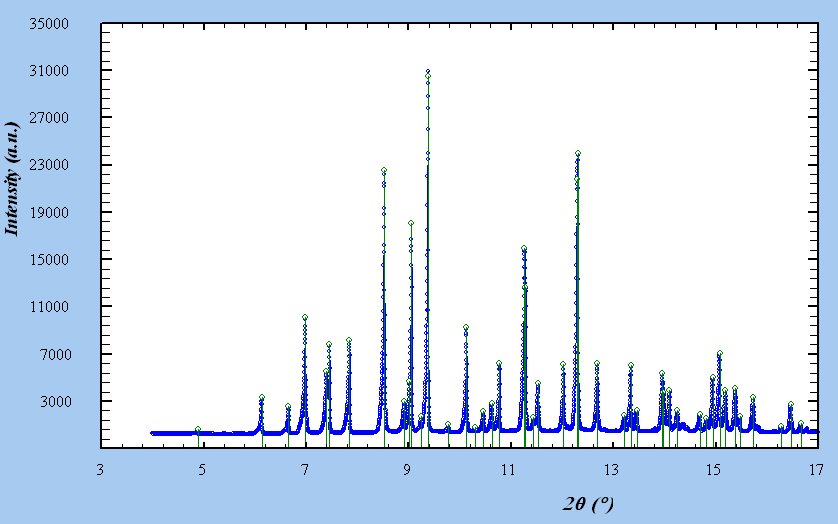 And this is the conventional powder pattern which was obtained (Bragg-Brentano - reflection)
almost free of preferred orientation (dusting the sample through a sieve - low resolution)
for comparison with the synchrotron pattern above (transmission - capillary) :
And this is the conventional powder pattern which was obtained (Bragg-Brentano - reflection)
almost free of preferred orientation (dusting the sample through a sieve - low resolution)
for comparison with the synchrotron pattern above (transmission - capillary) :
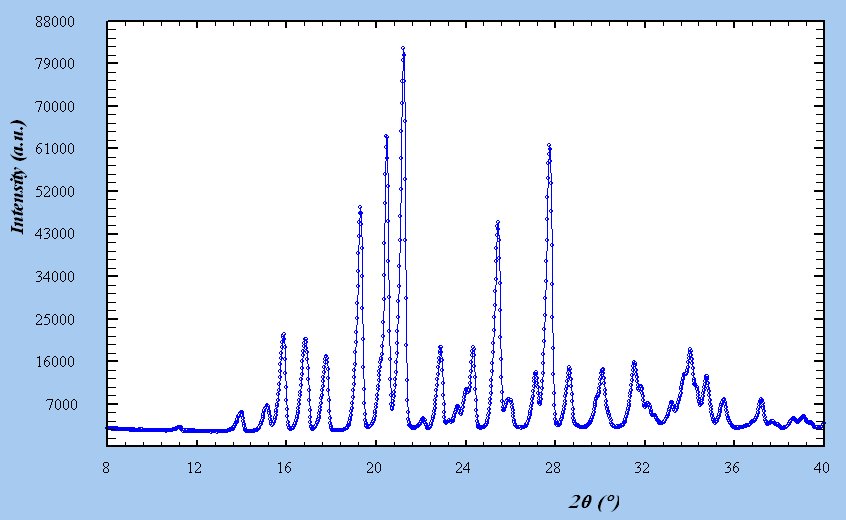 !!!!!!!!!!!!
!!!!!!!!!!!!
3-RESULTS
Most probable cell(s) according to the Participants :
UPPWs end in apotheosis...
Complete consensus on an obvious monoclinic cell giving high figures of
merit (FoM) from both the synchrotron and the new conventional X-ray data.
Most participants were curious to compare with the ICDD PDF 43-1748 and
46-1964 Grant-in-Aid entries, and found that both had a large zeropoint
error (~ -0.10°2-theta) and more or less impurity lines (8 impurity lines
among the first 25 ones for 43-1748 and 3 among the first 32 for 46-1964).
Moreover, one participant (Jacco van de Streek, CCDC) proposes the crystal
structure solved by using DASH.
Program a b c alpha beta gamma V
M(20) F 20 Unindexed Zero Spacegroup
TREOR (NM) 11.023 16.418 7.148 90. 126.49 90. 1040.0
(X-conv) M(20)= 47 F20 = 116 (0.006, 30) P21/a
TREOR (SG) 11.021 16.422 7.147 90. 126.48 90. 1040.0
(X-conv) M(20)= 41 F20 = 96 (0.007, 30) P21/a
CRYSFIRE (RS) 8.880 16.408 7.138 90. 93.86 90. 1037.7
(synch) up to 160 P21/n
EFLECH/INDEX (JB) 7.139 16.413 8.879 90. 93.83 90.
(synch)
X'PERT PLUS (JvM) 8.881 16.417 7.141 90. 93.86 90. 1038.7
(ITO, DICVOL, McMaille) (synch)
DICVOL (JvdS) 8.875 16.408 7.137 90. 93.84 90. 1036.9
(in DASH) (synch) M(20)=197 F20 = 1080 (0.0006, 32) P21/n
AUTOX (VZ) 7.153 16.421 8.880 90. 93.77 90. 1040.8
McMaille (ALB) 8.875 16.407 7.141 90. 93.82 90. 1037.6
(X-conv) M(20)=52 F20 = 127 (0.005, 31) P21/n
8.876 16.409 7.135 90. 93.83 90. 1036.8
(synch) M(20)=168 F20 = 888 (0.0008, 30) P21/n
Results from NM and SG (TREOR), Robin Shirley (CRYSFIRE), Joerg Bergmann (EFLECH/INDEX),
JvM (X'PERT PLUS : ITO, DICVOL, McMaille), Jacco van de Streek (DICVOL/DASH), Victor Zlokazov (AUTOX)
and Armel Le Bail (McMaille).
Plot by using DASH solving the crystal structure from the synchrotron data :
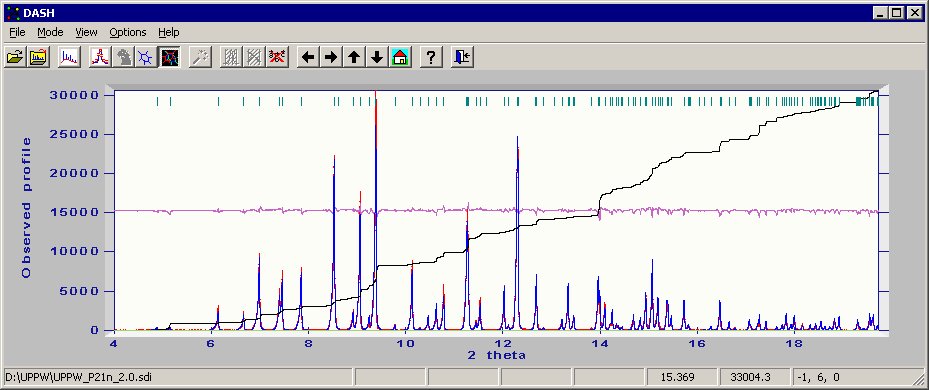
Plot by using ESPOIR solving the crystal structure from the synchrotron data :
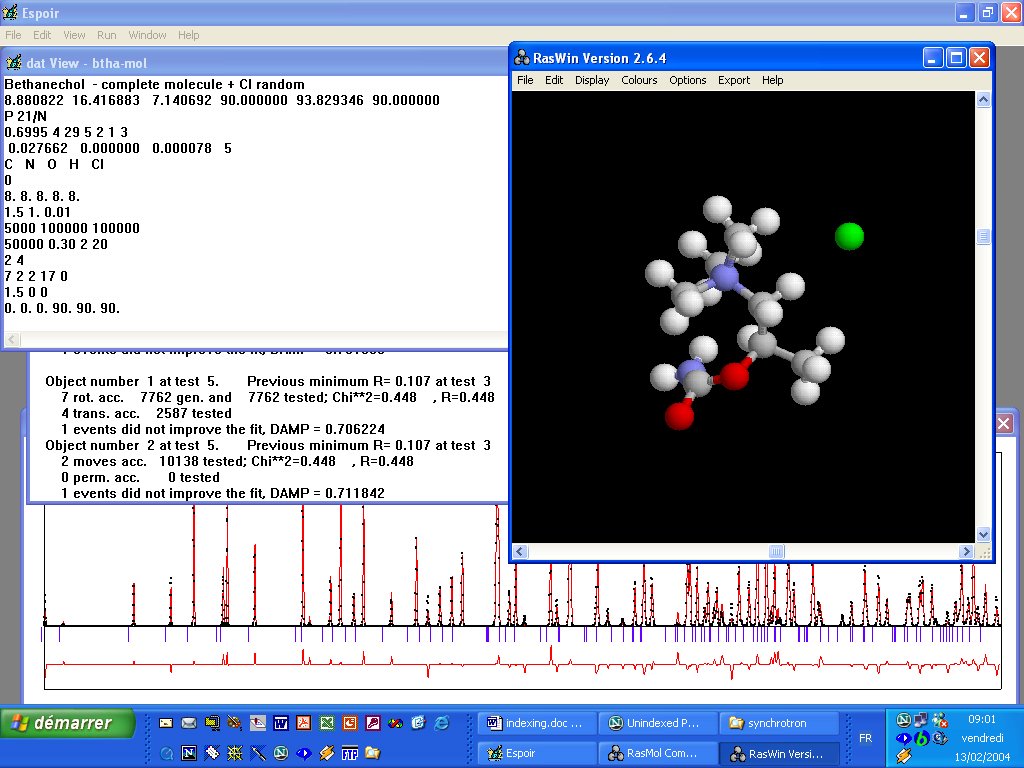
This is the end of UPPWs.
Thanks a lot to all participants !
 You may also use WinPLOTR for peak position extraction:
You may also use WinPLOTR for peak position extraction:
 And this is the conventional powder pattern which was obtained (Bragg-Brentano - reflection)
almost free of preferred orientation (dusting the sample through a sieve - low resolution)
for comparison with the synchrotron pattern above (transmission - capillary) :
And this is the conventional powder pattern which was obtained (Bragg-Brentano - reflection)
almost free of preferred orientation (dusting the sample through a sieve - low resolution)
for comparison with the synchrotron pattern above (transmission - capillary) :
 !!!!!!!!!!!!
!!!!!!!!!!!!

